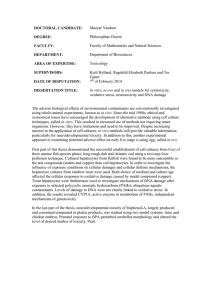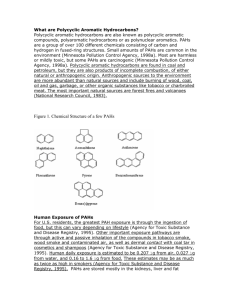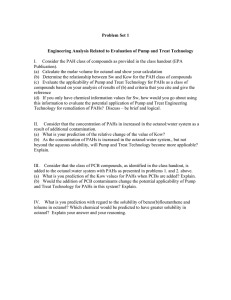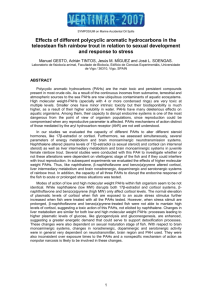Document 13359562
advertisement
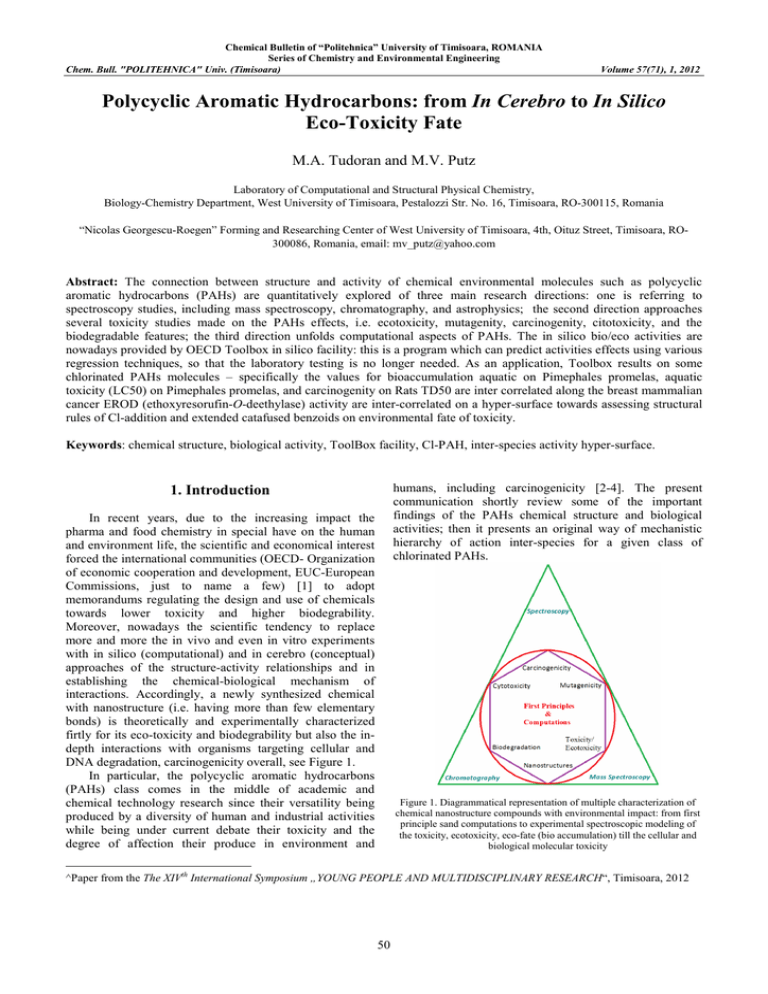
Chemical Bulletin of “Politehnica” University of Timisoara, ROMANIA Series of Chemistry and Environmental Engineering Chem. Bull. "POLITEHNICA" Univ. (Timisoara) Volume 57(71), 1, 2012 Polycyclic Aromatic Hydrocarbons: from In Cerebro to In Silico Eco-Toxicity Fate M.A. Tudoran and M.V. Putz Laboratory of Computational and Structural Physical Chemistry, Biology-Chemistry Department, West University of Timisoara, Pestalozzi Str. No. 16, Timisoara, RO-300115, Romania “Nicolas Georgescu-Roegen” Forming and Researching Center of West University of Timisoara, 4th, Oituz Street, Timisoara, RO300086, Romania, email: mv_putz@yahoo.com 1 Abstract: The connection between structure and activity of chemical environmental molecules such as polycyclic aromatic hydrocarbons (PAHs) are quantitatively explored of three main research directions: one is referring to spectroscopy studies, including mass spectroscopy, chromatography, and astrophysics; the second direction approaches several toxicity studies made on the PAHs effects, i.e. ecotoxicity, mutagenity, carcinogenity, citotoxicity, and the biodegradable features; the third direction unfolds computational aspects of PAHs. The in silico bio/eco activities are nowadays provided by OECD Toolbox in silico facility: this is a program which can predict activities effects using various regression techniques, so that the laboratory testing is no longer needed. As an application, Toolbox results on some chlorinated PAHs molecules – specifically the values for bioaccumulation aquatic on Pimephales promelas, aquatic toxicity (LC50) on Pimephales promelas, and carcinogenity on Rats TD50 are inter correlated along the breast mammalian cancer EROD (ethoxyresorufin-O-deethylase) activity are inter-correlated on a hyper-surface towards assessing structural rules of Cl-addition and extended catafused benzoids on environmental fate of toxicity. Keywords: chemical structure, biological activity, ToolBox facility, Cl-PAH, inter-species activity hyper-surface. humans, including carcinogenicity [2-4]. The present communication shortly review some of the important findings of the PAHs chemical structure and biological activities; then it presents an original way of mechanistic hierarchy of action inter-species for a given class of chlorinated PAHs. 1. Introduction In recent years, due to the increasing impact the pharma and food chemistry in special have on the human and environment life, the scientific and economical interest forced the international communities (OECD- Organization of economic cooperation and development, EUC-European Commissions, just to name a few) [1] to adopt memorandums regulating the design and use of chemicals towards lower toxicity and higher biodegrability. Moreover, nowadays the scientific tendency to replace more and more the in vivo and even in vitro experiments with in silico (computational) and in cerebro (conceptual) approaches of the structure-activity relationships and in establishing the chemical-biological mechanism of interactions. Accordingly, a newly synthesized chemical with nanostructure (i.e. having more than few elementary bonds) is theoretically and experimentally characterized firtly for its eco-toxicity and biodegrability but also the indepth interactions with organisms targeting cellular and DNA degradation, carcinogenicity overall, see Figure 1. In particular, the polycyclic aromatic hydrocarbons (PAHs) class comes in the middle of academic and chemical technology research since their versatility being produced by a diversity of human and industrial activities while being under current debate their toxicity and the degree of affection their produce in environment and Figure 1. Diagrammatical representation of multiple characterization of chemical nanostructure compounds with environmental impact: from first principle sand computations to experimental spectroscopic modeling of the toxicity, ecotoxicity, eco-fate (bio accumulation) till the cellular and biological molecular toxicity ^Paper from the The XIVth International Symposium „YOUNG PEOPLE AND MULTIDISCIPLINARY RESEARCH“, Timisoara, 2012 50 Chem. Bull. "POLITEHNICA" Univ. (Timisoara) Volume 57(71), 1, 2012 using ultraviolet photoelectron spectroscopy (UPS). Molecules like coronene, pyrene and their methoxy and keton-derivatives as polycyclic aromatic hydrocarbons, may be studied, and their theoretical and experimental electron binding energies of different MOs can be compared with TCNQ (tetracyanoquinodimethane) as a well-known classical acceptor. The studied compounds demonstrate how the functional groups can tune the molecules’ electronic state, providing moderate donor or strong acceptor properties [9]. Fullerenes are a class of chemicals which are synthesized by evaporation of carbon from at very high temperatures (that could reach the order of several thousand degrees Celsius). Recently, new methods of synthesis are experimented, while the recent computational methods as finite-temperature, non-equilibrium densityfunctional tight-binding molecular dynamics (DFTB/MD) simulations for the dynamic self-assembly processes of giant fullerene cages during benzene combustion have showed that PAH and subsequent fullerene self-assembly follow a disordered pathway from the opening of the aromatic hydrocarbon feedstock benzene molecules over the aggregation to clusters consisting of linear and branched polyacetylene-like radical open chains, followed by slow ring condensation which becomes faster the more hydrogens are removed from the system [10]. Finally, remarkably, in many astronomical objects was notice unidentified IR (UIR) bands, whose are susceptible to be attributed to PAHs at their origin. The method for assessing their presence requires, nevertheless, the calculation of the highly accurate fundamental frequencies and intensities not only for small molecules, but for largest one (PAHs molecule can contain between 30 and 50 carbon atoms). After testing of several methods, it seems like the most accurate and economical approach in order to compute the IR spectra for PAHs was the B3LYP functional in conjunction with the 4-31G basis set. The reported studies are promising in this direction, although the discussion continues nowadays [11]. 2. PAHs: structure, properties, activities One of the main pollutants in the environment, Polycyclic aromatic hydrocarbons (PAHs) class, are known for their photoinduced toxicity, which present two types of mechanisms: photosensitization reactions (considered as being dominant) with the formation of reactive oxygen species (ROS) and photomodification to more toxic photoproducts. Both may be rationalized by QSAR models on photoinduced toxicity of PAHs such as light absorption, generation of free radicals, or bioaccumulation of compounds in the biological tissue [5]. Polychlorinated naphthalenes (PCNs) were once known for their usage as lubricants, wood preservatives, plasticizers, and as by-product in technical synthesis of PCBs, but recently they become one of the most lubricants, wood preservatives, plasticizers, and as by-product in technical synthesis of PCBs. The most commune source of those molecules the industrial area, such as municipal waste incinerators(MWIs), metal refining, and pulp industry. Their standard gas-phase enthalpies of formation may be in silico evaluated by using, for instance, density functional theory (DFT) and second-order MuellerPlesset(MP2) theory [6]. Polycyclic aromatic hydrogens are in the attention of scientists also because it represent one of the largest classes of environmental carcinogens. In order to know more about the structure of those molecules, recently the process C16 H 10+ → C10 H 2+ that takes place in an ion trap mass spectrometer it was studied. Using DFT calculation and the approximation of Koopmans' Theorem, it was shown that the lowest energy structure is obtained from the linear form + of C10 H 2 . In addition, it was proven the utility of using a computational chemistry approach, in order to find more data about a series of unusual ion such as C10 H 2+ [7]. However, even if the PAHs molecules are not carcinogenic, it was proved that the metabolites of these molecules are. Those carcinogens derivates are benzo-ring diol epoxides in which the epoxide group is located besides the bay region of the molecule. A common example of a PAH, benzo[a]- pyrene (B[a]P), is activated by cytochrome P450 producing the ultimate carcinogen benzo[a]pyrene7,8-diol-9,10-epoxide (BPDE). Among the substances found in nature, one of them is ellagic acid (EA), found most in red raspberries, which is capable of chemically reacting with the B[a]P metabolites and preventing the covalent binding of BPDE to DNA. But, because of its toxicity at high concentrations, ellagic acid may not be an ideal drug. Further studies will have to find a way to designing novel ellagic acid derivatives that will also take into account their bioavailability and pharmacokinetics [8]. From the nanostructure point of view, it is known that, in functionalized polycyclic aromatic hydrocarbons (PAHs) the electronic state of the graphene-like hydrocarbon part is tuned by the functional group. In order to find new types of donor and acceptor molecules, concerned PAHs are studied 3. PAHs: inter-species toxicity’s hierarchy The Toolbox software, as developed by OECD, provides thoughtful read-across search based on the analogues categorization of the given chemical and hypothesis of mechanistically mode of action. The main features and resume of the algorithm was recently presented and applied on a paradigmatic short set of ClPAHs aiming for inter-species inter-activity correlation, see Table 1 and ref. [12]. The human-rat-fish results show that environmental fate is closer to the ecotoxicity that to carcinogenity, and that human is more exposed to fish hazard transfer of potentially toxic reagents that with the rat’s interaction, a matter reflected in teh order of activities displayed in Table 1 as well as in Figure 2. 51 Chem. Bull. "POLITEHNICA" Univ. (Timisoara) Volume 57(71), 1, 2012 TABLE 1. The the chlorinated polycyclic aromatic hydrocarbons (ClPAH) activities as: the EROD (ethoxyresorufin-O-deethylase) activity is taken from literature as the relative intensity of ClPAH-induced cytochrome P450 (CYP) activity in human breast cancer MCF-7 cells [13]; the computed activities with Toolbox facility are Environmental Fate: [Bioaccumulation aquatic] on Pimephales Promelas 96h [103 L/kg wet], BioFATEPp; Ecotoxicological Information: [Aquatic Toxicity] LC50 on Pimephales Promelas 96h [10–1 mg/L], LC50Pp; Carcinogenity on Rats TD50 [10-3 mol/kg], TD50Rats [12]. Cl-PAH Structure ACTIVITY BioFATEPp LC50Pp EROD TD50Rats 9-chloro phenanthrene (9-ClPhe) 1.90* 3.41* 1.2 4.72* 9,10-dichloro phenanthrene (9,10-Cl2Phe) 1.74* 1.3* 1.4 4.05* * ** 3,9,10-trichloro phenanthrene (3,9,10-Cl3Phe) 4.22 0.828 4.4 3.84** 1-chloropyrene (1-ClPy) 4.08* 1.3* 1.3 0.00511 6-chlorobenzo[a] pyrene (6-ClBaP) 4.22* 0.33** 9 3.46** * Predicted by Filling-in-the Data-Gap by Toolbox OECD facility [v.1.1.01/2009] with OASIS basesurface narcotis; ** by DNA binding of PAHs Figure 2. The (second order) interpolation of the eco-bio-activity hyper-surface as obtained by representing the eco-bio fate response for each of the chlorinated PAHs The hyper-surface Figure 2 provides nevertheless an interesting way for asses the eco-biological activities hierarchies among inter-species for a given pool of molecules. For the present case, one can see the peculiar features such as: 4. Conclusion The current importance of the PAHs in general on environment and every-day life is argued by various qualitative structure-activity circumstances, from spectroscopical to computational to bio-ecotoxicological and carcinogenicity level. For given compounds, here chlorinated-PAHS, the inter-activity hyper surface built upon preliminary inter-species correlation hierarchy is advanced as a proper tool in computationally predicting the addition and catafusing increasing effects of Cl-PAHs on bio-ecotoxicity effects. - For given PAH structure the chlorine addition drastically changing the biological fate of the obtained compound, inducing increasing effect on mammalians (human breast cancer and rats’ carcinogenicity); - Maintaining single addition of chlorine the higher activity fate is recorded as the skeleton PAH presents more pronounced bay to be further linked with the ecobiological receptor, favoring mammalian carcinogenicity in special. ACKNOWLEDGEMENT MVP thanks Romanian Ministry of Education and Research for supporting the present work through the CNCS-UEFISCDI project <Quantification of The Chemical Bond Within Orthogonal Spaces of Reactivity. Applications on Molecules of Bio-, Eco- and PharmacoLogical Interest>, Code TE-16/2010-2013. Further extended studies are required in order these results be suplemented with structure-activity quantitative studies, either as QSAR or Spectral-SAR [14] or even Logistical SAR [15] in cerebro-in silico approaches. 52 Chem. Bull. "POLITEHNICA" Univ. (Timisoara) Volume 57(71), 1, 2012 9. Naghavi S.S., Gruhn T., Alijani V., Fecher G.H., Felser C., Medjanik K., Kutnyakhov D., Nepijko S.A., Schönhense G., Rieger R., Baumgarten M. and Müllen K., Journal of Molecular Spectroscopy, 265, 2011, 95– 101. 10. Saha B., Shindo S., Irle S. and Morokuma K., ACS-NANO, 3(8), 2009, 2241–2257. 11. Bauschlicher C.W. and Langhoff S.R., Spectrochimica Acta Part A, 53, 1997, 1225-1240. 12. Putz M.V., Tudoran M.A. and Putz A.M., International Journal of Chemical Modeling, 4(4), 2012, 000-000. 13. Ohura T., Morita M., Kuruto-Niwa R., Amagai T., Sakakibara H. and Shimoi K., Environmental Toxicology, 25, 2010, 180–187. 14. Putz M.V., (Editor) QSAR & SPECTRAL-SAR In Computational Ecotoxicology. Apple Academics & CRC Press, Toronto-New Jersey, 2012. 15. Putz M.V. and Putz A.M., Structure and Bonding, 150, 2012, 000-000. REFERENCES 1. European Chemicals Agency, 2011, http://www.qsartoolbox.org. 2. International Programme on Chemical Safety (IPCS). Selected nonheterocyclic policyclic aromatic hydrocarbons. Environmental Health Criteria 202. 1998 [online]. Available URL: http://www.inchem.org/documents/ehc/ehc/ehc202.htm. 5/26/09. 3. International Programme On Chemical Safety (INCHEM) Polycyclic aromatic hydrocarbons, selected non-heterocyclic (EHC 202, 1998) Accessed 12.11.2010. 4. Bostrom C.E., Gerde P., Hanberg A., Jernstrom B., Johansson C., Kyrklund T., et al., Environ Health Perspectives, 110 3 Suppl, 2002, 451488. 5. Wang Y., Chen J., Li F., Qin H., Qiao X. and Hao C., Chemosphere, 76, 2009, 999–1005. 6. Wang L. and Lv G., Chemosphere, 78, 2010, 77–85. 7. Betowski L.D., Winnik W., Marcus A.B. Pyle S.M., International Journal of Mass Spectrometry and Ion Processes, 173, 1998, 27-39. 8. Huetz P., Mavaddat N. and Mavri J., Journal of Chemical Information and Modeling, 45, 2005, 564-1570. Received: 08 May 2012 Accepted: 21 June 2012 53



